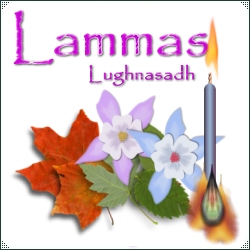
Lughnasadh
Frey Fest/Lughnasa/Lugnasad/Lammas
Frey Fest/Lughnasa/Lugnasad/Lammas
This is an Irish Gaelic name for the feast which commemorates the funeral games of Lugh, Celtic god of light, and son of the Sun. In the mythological story of the Wheel of the Year, the Sun God transfers his power into the grain, and is sacrificed when the grain is harvested. So we have a dying, self-sacrificing and resurrecting god of the harvest, who dies for his people so that they may live. Sound familiar?
The power of the sun goes into the grain as it ripens. It is then harvested and made into the first new bread of the season. This is the Saxon hlaef-masse or loaf-mass, now lammas. Seed grain is also saved for planting for next year's crop, so the sun god may be seen to rise again in Spring with the new green shoots, as the sun also rises in the sky. There are many traditions and customs all over the country that are still carried on at harvest-time today.
Lammas is a festival celebrating the first fruits of harvest, the fruits of our labours, and seeing the desires that we had at the start of the year unfold so rituals will be centred around this. Lammas is an early Christian festival, "lammas" means loaf mass and represented the first loaves baked from that years crop. These were taken to church and laid on the altar.
It's a time for bread-making and corn-dollies. Goddesses celebrated around this time include Demeter and Ceres. Trees associated with lammas are Hazel and Gorse and herbs are Sage and Meadowsweet. Colours associated with lammas are golds, yellows and orange for the God and red for the Goddess as mother.
LammasLammas is traditionally first harvest. Look around you and you will see various trees namely Rowan yeilding bright red berries and brambles showing ripening fruits alongwith apple and pear trees. In this day and age when food is mass produced and imported so we get fruits and veg and corn no matter what time of year it is, it is easy to loose touch with the natural cycle of things.
The power of the sun goes into the grain as it ripens. It is then harvested and made into the first new bread of the season. This is the Saxon hlaef-masse or loaf-mass, now lammas. Seed grain is also saved for planting for next year's crop, so the sun god may be seen to rise again in Spring with the new green shoots, as the sun also rises in the sky. There are many traditions and customs all over the country that are still carried on at harvest-time today.
Lammas is a festival celebrating the first fruits of harvest, the fruits of our labours, and seeing the desires that we had at the start of the year unfold so rituals will be centred around this. Lammas is an early Christian festival, "lammas" means loaf mass and represented the first loaves baked from that years crop. These were taken to church and laid on the altar.
It's a time for bread-making and corn-dollies. Goddesses celebrated around this time include Demeter and Ceres. Trees associated with lammas are Hazel and Gorse and herbs are Sage and Meadowsweet. Colours associated with lammas are golds, yellows and orange for the God and red for the Goddess as mother.
LammasLammas is traditionally first harvest. Look around you and you will see various trees namely Rowan yeilding bright red berries and brambles showing ripening fruits alongwith apple and pear trees. In this day and age when food is mass produced and imported so we get fruits and veg and corn no matter what time of year it is, it is easy to loose touch with the natural cycle of things.
Information from The White Goddess